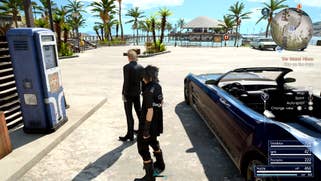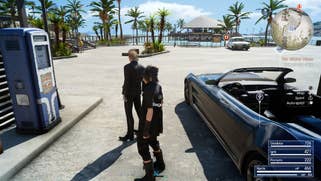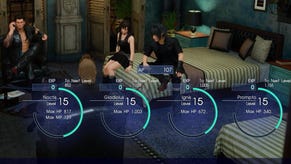Final Fantasy 15 on Stadia: an unambitious port of a great game
We expected more than 1080p at 30fps.
It's Final Fantasy 15, it's streaming from remote servers and by and large, it's identical to the existing console versions of the game - and that's quite a neat trick, especially when transitioning gameplay from 4K TV to laptop to smartphone. However, there's no doubt that there's a severe lack of ambition in this Stadia port in terms of it core technological credentials. Google's on-paper CPU and GPU spec out-strips Xbox One X in all dimensions - yet Final Fantasy 15 on Stadia runs at just 1080p at 30 frames per second, delivering an overall experience closer to the base PlayStation 4.
Of course, there are positives offered by the cloud and they shouldn't be overlooked - certainly in terms of sheer convenience. It's great to be able to buy a game and play it immediately; a Vulkan API optimised edition streaming to any Android phone, Chromecast or Chrome browser. There's no need to wait about for the current-gen consoles' gargantuan download to complete and loading times overall are much faster than PS4 or Xbox One.
Also, as a package, nothing has been left out. What Stadia offers is essentially the Royal Edition, with all updates and extra DLC bundled in. That even includes the recent Comrades multiplayer DLC, though for that, you'll only be matched with other Stadia users - there's no cross-play here, which is a shame. It's also worth noting Stadia's exclusive mini-games - four of them in fact - as revealed recently. It's not clear if these are timed exclusives, but for now, Stadia does have this plus point over consoles and PC.
The best way to play on Stadia is through Chromecast - notably the Ultra version which enables 4K streaming of the game. Sadly, running through the Google Chrome browser on PC fixes the game to a lower bitrate, at a 1080p output. For our work, we accessed the 4K feed on a 300mbps connection rated 'excellent' by the service. We've had some issues here actually - sometimes the same connection is merely rated 'good' and we don't get 4K at all.
Regardless, the blunt truth here is that even with a 4K video stream, pixel counts of the image still come in at a native 1920x1080. As you'll see in the video and the comparison images on this page, there's no competition when stacked up against Xbox One X's 4K mode, which actually runs at a dynamic resolution with 3360x1890 at the top end. There's a big drop in image quality as a result, even without factoring in Stadia's inherent compression. Fundamentally, the image streamed across simply isn't a 4K picture, or anything close to it - despite it saying so. The only benefit I can see to having 4K activated in the menus is more bandwidth allocation to getting an upscaled 1080p across, which will result in a clearer image.
The enhanced consoles also delivered three different display modes - high, stable and lite - but unfortunately, Stadia forgoes this, leaving you with one standard mode. Think of this as a higher resolution version of the base console feature set. The only video option to play with is a luminance slider for HDR. It's great that we have HDR support at least, but we're still fixed at 1080p, and 30 frames per second. The overall setup just does not compare to Xbox One X - and this extends to visual features beyond pixel-count.
Stadia presents in a similar manner to the base console versions of the game, equivalent to the 'lite' mode on PS4 Pro and Xbox One X. However, in X's case we have a high mode that delivers improved visual settings, boosted LODs and better texture filtering. Stadia by comparison, holds up in draw distance, and effects work. We have matching car reflections - accepting a small variance in cloud cover - while shadow quality is identical. One difference concerns ambient occlusion, which is thicker and darker on Stadia. It's also clear that depth of field and texture filtering are of a lower quality on Stadia. Part of this is may be down to rendering at a different resolution, but certainly, texture clarity is affected on Stadia at low angles. Again, this is more in line with the base console versions of the game.








Overall then, the convenience and 'magic' of streaming a huge game like this is offset by the baffling lack of ambition. The big disappointment is that the Stadia hardware server-side simply isn't pushing the boat out. There's nothing close to the level of detail seen on the Windows Edition. The increased vegetation, improved tessellation, and improved model LODs of that version don't make the grade. I even tried running through the browser version, to see if there's an alternative rendering mode - as we saw in Red Dead redemption 2 running at 60fps there - and it's the same 1080p30 setup. There is a consolation that it's a step above base console specs, at least. Base PS4 is dynamic 1080p of course, but could drop to 900p at its lowest - whereas Stadia delivers a stable pixel output.
While the apparent under-utilisation of Stadia's CPU and GPU spec is absolutely baffling, we do get the advantages of server-grade storage. As a result, Stadia beats Xbox One X in simply getting to the action, cutting the wait down by over 50 per cent. Case in point: starting a new game takes 21 seconds to clear the loading screen on Stadia and that's compared to a 49 second wait on Xbox One X. It all comes back to the point of convenience; there's no waiting around for installs, and equally we get a huge drop in down-time between areas in the game, which is another plus point in Stadia's favour.
Frame-rate is worth touching on. Frustratingly it only runs at 30fps rather than pushing for 60fps - as we saw with Destiny 2 on Stadia. It's fully v-synced much like PS4 and Pro on its high setting, and even has occasional frame-pacing variances like those editions. That being said, it's still very solid. In fact, I haven't seen any regular drops under 30fps, at least based on early samples. Arguably the best part about Stadia being so under-ambitious in resolution and visual settings is the knock-on benefit it has for performance. Streaming quality can be an issue though: you'll notice lurches and hiccups depending on your setup. Accepting that's a network fault though, the game actually being beamed across is respectable, performance-wise.
In summary, Final Fantasy 15 on Stadia is far from what I'd imagined going into this project. In terms of flexibility it's an unparalleled way to enjoy the game. Leave the house, and you can carry on using your Android phone - an incredible feat, assuming there's network coverage. But as a premiere home experience, Stadia had a big chance here to topple Xbox One X and push closer to PC territory in visual quality. That's not what we have. In summary, it's a 1080p, 30fps experience using console-grade visual settings - and with HDR as an option. The advantage of shorter loading times and a tighter lock on 30fps works in its favour, but a lot of this still rests on your network quality in delivering a consistent experience. Add in the extra input lag during combat, and it's hard to see a positive trade-off in playing this over a dedicated home console edition.










